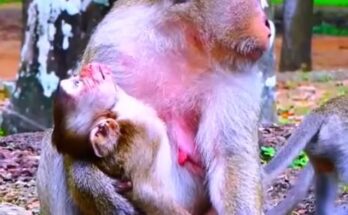“Little Monkey Illness” is a colloquial term often used to refer to a condition medically known as Hand, Foot, and Mouth Disease (HFMD). It is a common viral infection primarily affecting young children, though adults can also get it. The name “Little Monkey Illness” likely comes from the way children, especially those in daycare or kindergarten, interact closely with each other, akin to the playful nature of monkeys. This viral infection is easily spread in environments where children gather, making it especially prevalent in schools and daycare centers. In this article, we will explore the symptoms, causes, and treatment options for Hand, Foot, and Mouth Disease.
Symptoms of Little Monkey Illness (HFMD)
Hand, Foot, and Mouth Disease typically starts with mild fever, sore throat, and a general feeling of unwellness. As the infection progresses, more specific symptoms develop. These include:
- Rash: A characteristic rash often appears on the palms of the hands, soles of the feet, and sometimes on the buttocks. The rash usually begins as red spots and may turn into blisters. These blisters can be painful, making walking or using hands difficult.
- Mouth Sores: Painful sores or ulcers develop inside the mouth, particularly on the tongue, gums, and inside the cheeks. These sores can make eating and drinking painful, leading to dehydration if the child refuses to drink enough fluids.
- Fever: A low-grade fever is common, especially in the early stages of the illness.
- Irritability: Children may become irritable due to the discomfort caused by the rash and mouth sores. Younger children might also have trouble sleeping or eating.
- Loss of Appetite: Because of the mouth sores, children may experience a significant loss of appetite, which can contribute to dehydration.
- Other Symptoms: Some children may experience mild respiratory symptoms such as a runny nose or cough, but this is not always the case.
Causes of Little Monkey Illness
Hand, Foot, and Mouth Disease is caused by a group of viruses known as enteroviruses, with the most common being the Coxsackievirus A16 and Enterovirus 71. The virus spreads from person to person through direct contact with bodily fluids such as saliva, mucus, and stool. Transmission can occur through:
- Close contact with an infected person, including hugging, kissing, or sharing toys.
- Touching contaminated surfaces, such as doorknobs, toys, or tables, where the virus can survive for a short time.
- Aerosolized droplets, which can be spread through coughing and sneezing.
- Fecal-oral route, meaning the virus can be passed when an infected person does not wash their hands after using the bathroom.
The disease is most contagious during the first week of illness, but the virus can remain in the body for weeks after symptoms disappear, allowing for further spread.
Treatments for Little Monkey Illness
Currently, there is no specific antiviral treatment for Hand, Foot, and Mouth Disease. The infection is generally self-limiting, meaning it resolves on its own within 7 to 10 days. However, there are several steps that can help manage symptoms and prevent complications:
- Pain Relief and Fever Reduction: Over-the-counter medications like acetaminophen (Tylenol) or ibuprofen (Advil) can help reduce fever and relieve pain caused by mouth sores and the rash. However, aspirin should be avoided, especially in children, due to the risk of Reye’s syndrome.
- Hydration: Encouraging children to drink plenty of fluids is crucial to prevent dehydration, especially if mouth sores are making it difficult to eat or drink. Cool fluids like water, clear soups, or ice pops can be soothing.
- Topical Treatments: Soothing creams or ointments, such as calamine lotion, may help relieve itching and discomfort from the rash. For mouth sores, saltwater rinses or mouth gels can provide temporary relief.
- Rest: Giving the child plenty of rest is important for their recovery. Rest helps the body’s immune system fight off the infection.
- Good Hygiene Practices: To prevent the spread of the virus, caregivers should wash their hands frequently, disinfect commonly touched surfaces, and avoid sharing eating utensils or drinks with the infected child.
Prevention
While it is difficult to prevent Hand, Foot, and Mouth Disease completely, there are several measures that can help reduce the spread of the virus:
- Handwashing: Encourage frequent and thorough handwashing, especially after using the bathroom, changing diapers, or before eating.
- Avoiding close contact: Infected individuals should avoid contact with others, especially young children, during the contagious period.
- Cleaning and disinfecting: Regularly disinfect surfaces, toys, and other items that children frequently touch.
Conclusion
Hand, Foot, and Mouth Disease, commonly referred to as Little Monkey Illness, is a viral infection that primarily affects young children but can also affect adults. It is characterized by a rash on the hands, feet, and other parts of the body, along with painful mouth sores, fever, and irritability. Although there is no specific treatment, managing symptoms and preventing dehydration are key. Proper hygiene practices can help reduce the risk of spreading the virus, making it important for caregivers to maintain good handwashing habits and keep infected children at home until they recover. While the illness is generally mild and resolves on its own, complications can arise in rare cases, so it’s important to seek medical attention if symptoms worsen.


